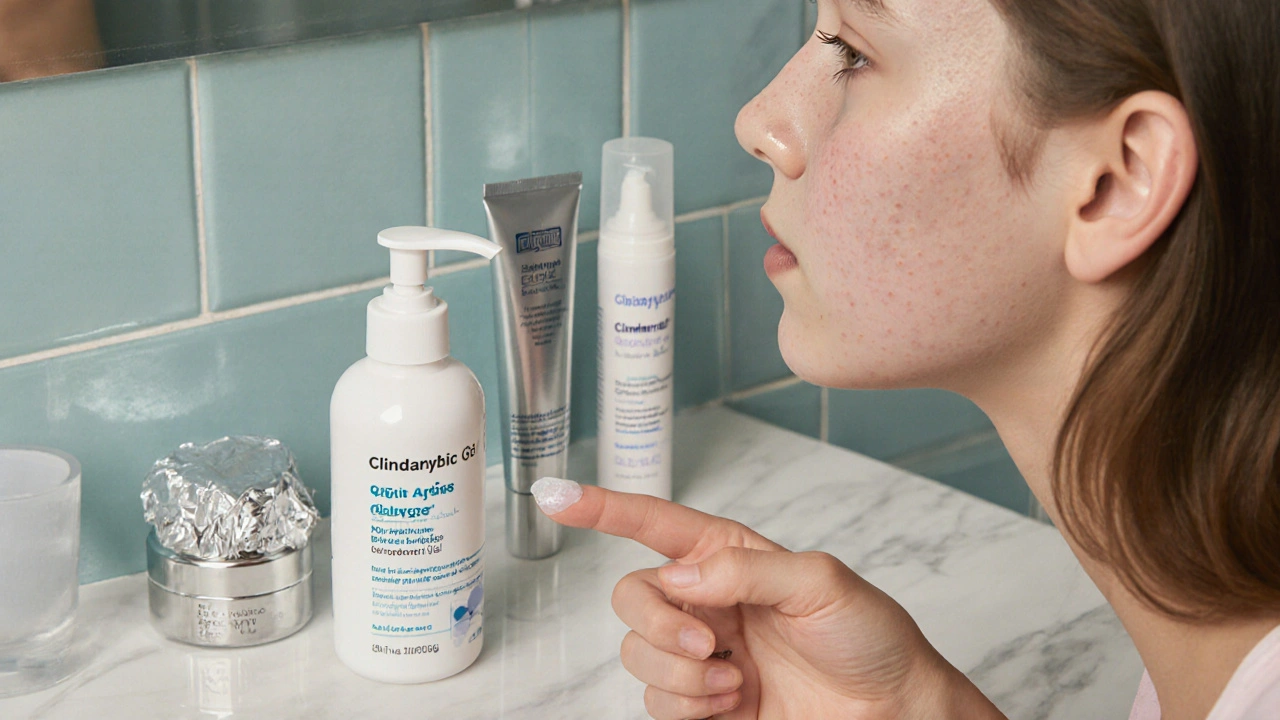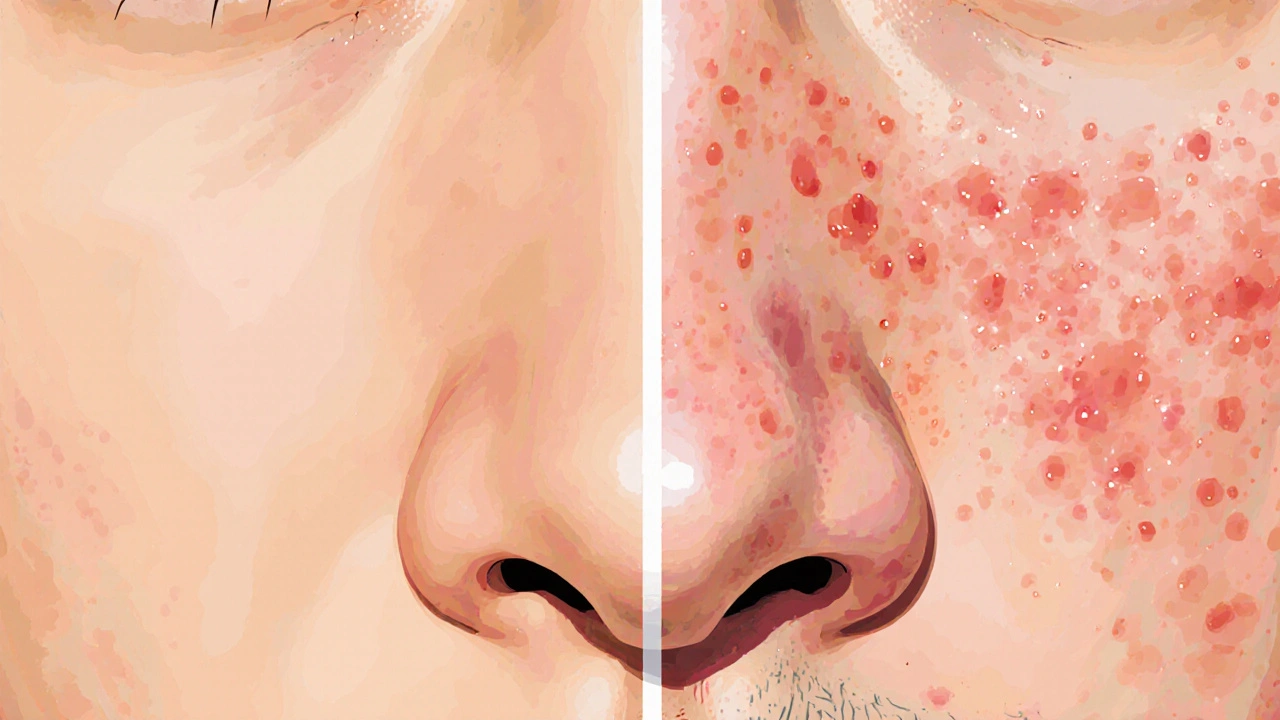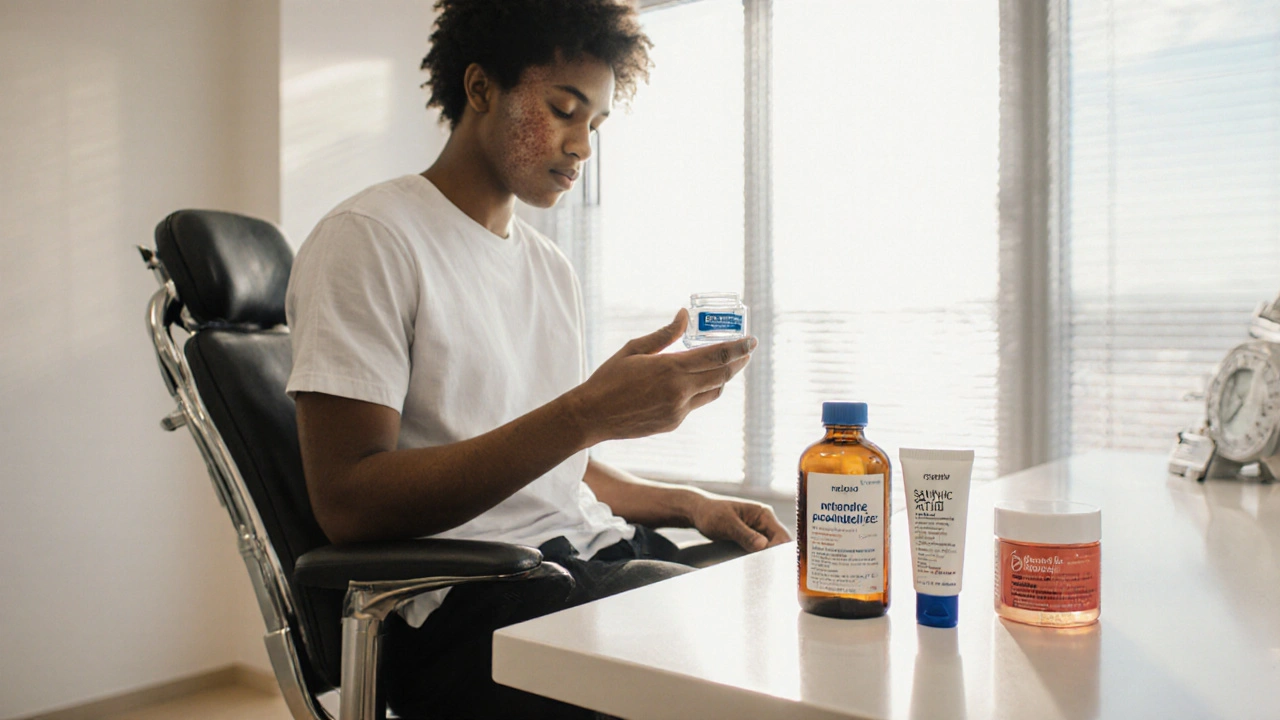Acne Treatment Selector
Find the best acne treatment option based on your symptoms and preferences.
1. What type of acne do you have?
2. How sensitive is your skin?
3. Are you looking for a prescription or over-the-counter solution?
Quick Take
- Clindamycin gel is a prescription‑only topical antibiotic that fights acne‑causing bacteria.
- It’s best for inflammatory lesions and works well when paired with a retinoid or benzoyl peroxide.
- Common alternatives include benzoyl peroxide, adapalene, tretinoin, oral doxycycline, salicylic acid, azelaic acid, and tea tree oil.
- Side‑effects range from mild dryness to rare antibiotic resistance.
- Cost and convenience vary widely; generic versions are affordable, while some alternatives need a doctor’s script.
Clindamycin Gel is a topical prescription antibiotic formulated in a gel base, primarily used to treat moderate to severe inflammatory acne vulgaris. It works by inhibiting bacterial protein synthesis, targeting Cutibacterium acnes (formerly Propionibacterium acnes). The gel delivers a steady 1% concentration, allowing it to penetrate the follicular wall without causing excessive dryness.
How Clindamycin Gel Works
The active molecule binds to the 50S ribosomal subunit of the bacteria, preventing the formation of essential proteins. This bacteriostatic action reduces the bacterial load, which in turn lowers inflammation and lesion formation. Because it stays on the surface, systemic absorption is minimal-studies show serum levels stay under 0.5ng/mL even after daily use for four weeks.
Key Alternatives to Consider
When doctors prescribe clindamycin, they often pair it with a second‑line agent or suggest a switch if results plateau. Below is a snapshot of the most frequently recommended alternatives.
Benzoyl Peroxide is a keratolytic oxidizing agent that kills bacteria through free‑radical generation. Available over‑the‑counter in concentrations from 2.5% to 10%, it reduces oil production and unclogs pores.
Adapalene is a third‑generation synthetic retinoid (0.1% or 0.3% gel) that modulates cell differentiation, reduces keratin buildup, and has anti‑inflammatory properties. It’s marketed as a prescription‑free option in many countries.
Tretinoin (all‑trans retinoic acid) is a potent vitaminA derivative used for both acne and photo‑aging. Concentrations range from 0.025% to 0.1% cream or gel, and it requires a gradual build‑up to minimize irritation.
Doxycycline is an oral tetracycline antibiotic (usually 40mg or 100mg once daily). While not topical, it’s frequently combined with clindamycin for severe nodular acne because it reaches deeper pores and reduces systemic inflammation.
Salicylic Acid is a beta‑hydroxy acid (BHA) that dissolves intercellular “glue”, helping exfoliate the follicular lining. Over‑the‑counter formulas range from 0.5% to 2% in wipes, toners, and leave‑on gels.
Azelaic Acid is a dicarboxylic acid (10%-20% cream or gel) that exhibits antibacterial, keratolytic, and melanin‑inhibiting effects, making it useful for both acne and post‑inflammatory hyperpigmentation.
Tea Tree Oil is a natural essential oil with documented antimicrobial activity against Cutibacterium acnes. Diluted formulations (5%-10% in carrier oils) are popular among patients seeking non‑prescription options.
Side‑Effect Profile Comparison
| Agent | Mechanism | Typical Use | Common Side Effects | Resistance Risk | Cost (US$) per month* |
|---|---|---|---|---|---|
| Clindamycin Gel | Protein synthesis inhibition (bacterial) | Inflammatory papules/pustules | Dryness, mild erythema | Low‑moderate (if monotherapy) | 15‑30 |
| Benzoyl Peroxide | Free‑radical oxidation (bacterial) | All acne types, often first‑line | Bleaching, irritation, itching | Very low | 5‑20 |
| Adapalene | Retinoid receptor modulation | Comedonal & inflammatory acne | Peeling, redness, sun‑sensitivity | None (non‑antibiotic) | 10‑25 |
| Tretinoin | Retinoic acid receptor agonist | Severe acne, anti‑aging | Severe irritation, peeling | None | 12‑30 |
| Doxycycline | Protein synthesis inhibition (systemic) | Moderate‑severe nodular acne | GI upset, photosensitivity | Moderate (systemic resistance) | 20‑40 |
| Salicylic Acid | Keratinocyte exfoliation (BHA) | Blackheads & oily skin | Dryness, stinging | None | 5‑15 |
| Azelaic Acid | Antibacterial + keratolytic | Inflammatory acne, PIH | Burning, tingling | Low | 15‑35 |
| Tea Tree Oil | Essential oil antimicrobial | Mild‑to‑moderate acne | Allergic dermatitis | Very low | 5‑20 (DIY) |
*Prices are average US retail values for generic or over‑the‑counter versions, based on 2025 market data.

When to Choose Clindamycin Gel
If you have primarily inflamed papules or pustules that haven’t responded to benzoyl peroxide or a retinoid, clindamycin gel can cut the bacterial load quickly. It’s also a good partner for topical retinoids because the antibiotic tackles inflammation while the retinoid normalizes skin turnover.
Ideal scenarios:
- Moderate acne with frequent breakouts at night.
- Patients who experience stinging with benzoyl peroxide but need antibacterial action.
- Individuals on oral contraceptives who want a non‑systemic option.
However, avoid long‑term monotherapy. Guidelines from dermatology societies (2024) recommend rotating or combining with a non‑antibiotic agent after 3‑4 months to curb resistance.
How to Combine Clindamycin with Other Agents
- Morning routine: Apply a thin layer of clindamycin gel after cleansing, wait 15minutes, then follow with a sunscreen. If you also use benzoyl peroxide, apply it on the opposite side of the face or wait another 30minutes to reduce irritation.
- Evening routine: Cleanse, then apply a retinoid (adapalene or tretinoin). Allow the retinoid to absorb (10‑15minutes) before layering clindamycin if prescribed twice‑daily.
- Adjunct oral therapy: For severe nodular acne, a short course of doxycycline (40mg daily) can be added for 3‑4 months, then tapered.
Always monitor for signs of excessive dryness; a non‑comedogenic moisturizer can offset barrier disruption.
Special Populations & Considerations
Pregnant or breastfeeding patients should consult a dermatologist before starting clindamycin, as systemic absorption is low but not zero. Teenagers may benefit from the combo of clindamycin and adapalene, which offers a gentle yet effective regimen.
Patients with a history of antibiotic‑resistant Cutibacterium acnes should consider non‑antibiotic alternatives like benzoyl peroxide or azelaic acid.
Cost‑Effectiveness Overview
Generic clindamycin gel costs roughly $15‑$30 per month, comparable to many OTC retinoids. Benzoyl peroxide is cheaper but may require higher concentrations that increase irritation. Oral doxycycline adds prescription fees and potential GI side‑effects, making the overall cost higher for long‑term use.
Insurance plans often cover clindamycin gel when prescribed for acne, while many OTC alternatives are out‑of‑pocket. For budget‑conscious users, a rotation strategy-starting with benzoyl peroxide, then adding clindamycin for flare‑ups-can stretch the budget.
Key Takeaways
- Clindamycin gel offers targeted antibacterial action with minimal systemic exposure.
- Pairing with a non‑antibiotic (retinoid or benzoyl peroxide) maximizes efficacy and lowers resistance risk.
- Alternative agents each have distinct mechanisms; choose based on lesion type, skin tolerance, and cost.
- Monitor for dryness and rotate therapies after 3‑4 months.
- Consult a dermatologist for personalized regimens, especially if you have severe acne or special health considerations.

Frequently Asked Questions
Can I use clindamycin gel together with benzoyl peroxide?
Yes, but space them out. Apply benzoyl peroxide in the morning, wait at least 30minutes, then use clindamycin gel. This limits irritation while keeping antibacterial coverage.
How long does it take to see results with clindamycin gel?
Most patients notice reduced redness and fewer new pimples within 2‑4weeks. Full clearing can take 8‑12weeks, especially if combined with a retinoid.
Is antibiotic resistance a real concern with topical clindamycin?
Resistance can develop if clindamycin is used alone for longer than 3‑4months. Dermatology guidelines advise adding a non‑antibiotic (e.g., benzoyl peroxide) or rotating to a different class.
What are the main side effects of clindamycin gel?
Typical side effects are mild skin dryness, occasional redness, and rarely contact dermatitis. Using a fragrance‑free moisturizer can mitigate most complaints.
Can teenagers use clindamycin gel safely?
Yes. Teens often benefit from the combination of clindamycin and a low‑strength retinoid like adapalene 0.1%. A dermatologist should supervise to adjust dosage and monitor skin response.
Is clindamycin gel covered by insurance?
Most U.S. plans cover prescription clindamycin gel for acne when a dermatologist writes the prescription. Check your formulary; generic versions are usually the most affordable.
How does clindamycin compare to oral doxycycline?
Clindamycin acts locally with minimal systemic exposure, making it gentler on the gut. Doxycycline works systemically, reaching deeper lesions but can cause photosensitivity and gut upset. Often they’re used together for severe cases.
